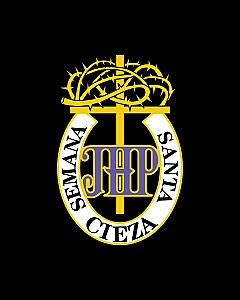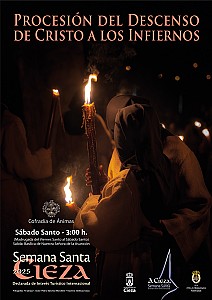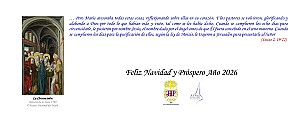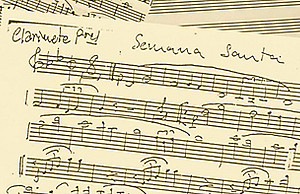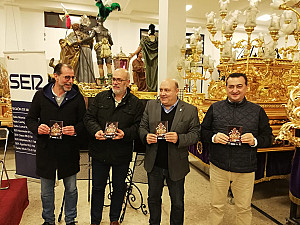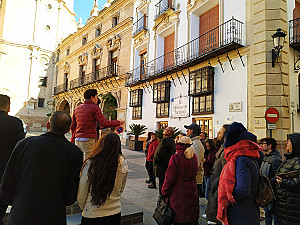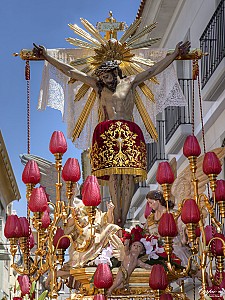El Paso del Santísimo Cristo del Consuelo, el 'Santo Cristo' de los ciezanos, va indisolublemente unido a la leyenda y a su ermita extramuros, y su devenir en el tiempo sigue planteando hoy día algunos interrogantes.
La leyenda, impresa por primera vez en el siglo XIX, que vincula la llegada del Santísimo Cristo del Consuelo a Cieza en el año 1606 merced a un hecho milagroso (el tiro de bueyes que transportaba al 'Santo Cristo' para una población manchega se paró ante un cabezo cercano a Cieza negándose a continuar; interpretado el hecho como un deseo de la Imagen de quedarse entre los ciezanos, allí mismo se le edificó una ermita) debe ser valorada en su justa medida, pues es común a muchas otras localidades.
Lo cierto es que en el mencionado cabezo, conocido originariamente como Cabezo de las Horcas (hoy Barrio de la Horta), existía un sencillo humilladero levantado por iniciativa de la comunidad francisca bajo la advocación 'del Calvario' que como tal consta en la 'Relación' de Felipe II de 1579; a este lugar se accedía por el Camino de Castilla (hoy carretera de Calasparra) que discurría a los pies de dicho cabezo. En 1612 y a instancias del Presbítero D. Ginés de Mellinas se inicia, sobre ese primitivo humilladero, la construcción de una ermita, así como de un vía crucis, del que hoy todavía se conservan restos, en el tramo del Camino de Castilla que conducía desde la población al mencionado cabezo para finalizar en las cuestas del mismo. Ese mismo año D. Diego Padilla sufraga de su propio peculio el Crucificado que ha de presidir dicha ermita, posiblemente de cartón, con el fin de que, gracias a su poco peso, con él se practicara el rezo del Via Crucis en la madrugada de Viernes Santo.
El Cristo, bajo una primera advocación 'del Calvario' queda provisionalmente instalado en la iglesia parroquial de la villa en tanto no concluyen las obras de aquella. Acabadas estas como muy tarde en 1614 (en su testamento de ese año Dña. Isabel Ruiz lega un dinero "para la obra de la ermita nueva que se ha hecho en el cabezo de las horcas") se colocan en la ermita el mencionado Crucificado y una Imagen de la Virgen del Buen Suceso. Desde esas fechas la ermita pasó a ser conocida indistintamente como Ermita de Ntra. Sra. del Buen Suceso (así, en el testamento de Dña. Ana Marín de 1621 se establecen "cuatro misas rezadas y estas se digan en la Ermita de Ntra. Sra. del Buen Suceso de esta villa en su altar reservado") y como Ermita del Santo Cristo del Calvario (tal como aparece referida en el Acta Capitular de 1745 en que se nombra a la Virgen del buen Suceso Patrona de Cieza), aunque el Cristo será denominado popularmente como el 'Santo Cristo' o 'el Señor' (así en el testamento de Dña. Inés Valera de 1624 se manda decir "dos misas rezadas en el altar reservado al Santo Cristo en la ermita de Ntra. Sra. del Buen Suceso"), apelativos que persisten para la actual Imagen.
No obstante a principios del siglo XVIII gozó también de capilla propia en la Iglesia de Nuestra Señora de la Asunción, una capilla importante y de grandes dimensiones en la que solicitan ser enterrados muchos vecinos de la villa: así consta por ejemplo en el testamento otorgado por Dña. Ana Marín Melgarejo en el año 1722. Tras la remodelación definitiva de la Iglesia de Nuestra Señora de la Asunción a finales del siglo XVIII dicha capilla deja de mencionarse sin que hasta nuestros días nos haya llegado noticia de ninguna otra capilla vinculada a dicha advocación.
Desde la ermita y en los primeros años del siglo XIX el 'Santo Cristo', al que en los decenios siguientes se denomina ya inequívocamente 'Santo Cristo del Consuelo', baja en rogativa en los años 1800 y 1805, atribuyéndosele algunos milagros que incrementan desmesuradamente la devoción y el culto popular a la Imagen. Tal es así que en 1807 D. Domingo Morata, Párroco de la Parroquia de Nuestra Señora de la Asunción, decide escribir una "Novena al Santísimo Cristo del Consuelo, que se venera en su ermita extramuros de la villa de Cieza", Novena que se viene celebrando en los días que anteceden a la festividad de la Cruz el tres de mayo en la Basílica de Nuestra Señora de la Asunción. No obstante, la ermita seguirá siendo referida en diversos documentos unas veces (1846) como 'Ermita del Santo Cristo del Consuelo' y otras (1855) como 'Ermita de la Virgen del Buen Suceso', hasta que entre 1864 y 1879, según el proyecto inicial del arquitecto Juan José Belmonte que concluyó, tras su muerte, su homólogo Justo Millán, se edifique en el mismo sitio la ermita actual y, fruto de la enorme veneración que los ciezanos le profesaban, se le otorgue definitivamente este último nombre, siendo en el año 1888 cuando el Papa León XIII concede la consagración de un altar a la Imagen e indulgencias para todos aquellos por los que se dijera Misa en él.
Con la construcción de la nueva Ermita la práctica del Vía Crucis caerá en desuso hasta desaparecer en los primeros años del s. XX. De ese modo, el Smo. Cristo del Consuelo que ocasionalmente había participado en las Procesiones de Semana Santa, comenzará a hacerlo ininterrumpidamente desde entonces en las Procesiones General, del Penitente y del Santo Entierro (en esta dejó de hacerlo -en virtud del acuerdo de reorganización de las Procesiones, una de cuyas premisas limitaba el número de salidas procesionales a dos-). Y para su participación en las mismas, el Paso se traslada desde su ermita en la tarde del Domingo de Ramos al menos desde el año 1932, pero hasta esa fecha su Traslado tenía lugar, al menos desde la construcción de la Ermita, en el marco de la 'Traída de los Santos' en la tarde de Jueves Santo, habiéndose realizado también ocasionalmente (1943) en la noche de Martes Santo.
Es evidente, por otra parte, que en el transcurso de los años la Hermandad del Smo. Cristo del Consuelo hizo suyas algunas características y usos de la desparecida Cofradía de la Sangre; así, igual que la Cofradía de la Sangre procesionaba en la Procesión del Santo Entierro desde sus orígenes con la Cruz sola, tras desenclavar al Cristo para colocarlo en la urna del Santo Sepulcro, también la Hermandad del Santísimo Cristo del Consuelo procesionará con el Paso de la Santa Cruz (actualmente, por el deteriorado estado de aquella, lo hace con el titular), desenclavando a su vez la Imagen del Cristo (así lo confirma una crónica de la Semana Santa de 1893 publicada en el periódico 'El Orden': "En las Procesiones de Jueves Santo y Viernes Santo en la mañana... ostentando riquísimo sudario de nipis bordado... que fue traído expresamente desde Manila para esta imagen por su generoso donante D. Pascual Arce natural de Cieza, iba Cristo en la Cruz, de cuyo arreglo es la encargada Dña. Luisa Fernández de Castro, viuda de Marín-Blázquez... En la Procesión de Viernes Santo en la noche formaba la Santa Cruz que erguida y sola conserva el sudario de que ya se hace mención..."). Por último cabe resaltar que desde entonces, además de admitir en su cortejo penitentes de paisano, la Cofradía mantuvo la costumbre de que los nazarenos de su Tercio, algunos de ellos descalzos, desfilaran con cruces de madera en la Procesión del Penitente, Viernes Santo en la mañana,
En cuanto a las conexiones entre las propias Imágenes, y aunque se desconozca la factura del que pudo ser el Cristo de la Sangre, estas debieron ser bastante obvias por cuanto la Imagen del Santísimo Cristo del Consuelo ha estado acompañada siempre por la pequeña escultura de un ángel que en tiempos llevó un cáliz en su mano, representación iconográfica frecuente en los Pasos con la advocación de 'la Sangre'.
A finales del siglo XIX la familia Marín-Blázquez habría constituido la Hermandad con un carácter eminentemente devocional o de culto, y orientada sobre todo al Traslado del Paso para las Procesiones de Semana Santa y a la organización de los actos (novena y procesión) con motivo de la festividad del tres de mayo, Día de la Cruz, en que la Imagen retornaba a su ermita; al frente de la misma figura como primer Hermano Mayor D. Manuel Marín-Blázquez y Marín-Ordóñez, y como primera Camarera Dña. Concepción Marín-Blázquez y Capdevila, función que desempeñó hasta hace muy pocos años Dña. Piedad Marín-Blázquez. Como tal, la Hermandad consta en varios apuntes del Libro de Cuentas de la Cofradía de Jesús: "Por préstamo de diez libras de cera a la Hermandad del Santo Cristo"; pero un artículo aparecido en 1892 en el periódico local 'El Enredo', cuyo autor se queja de que "algunas Cofradías, como la del Santo Cristo, no admiten Cofrades en su seno", viene a demostrar que, por lo que a las Procesiones de Semana Santa se refiere, la Hermandad era en realidad una Camarería; el hecho, además, de que aquella no se encuentre entre las constituyentes de la Junta de Hermandades Pasionarias en 1914 permite pensar que todavía en estas fechas el Paso del Santísimo Cristo del Consuelo participa en las Procesiones de Semana Santa sin Cofradía propia.
De hecho no será hasta 1932 cuando D. Manuel Marín-Blázquez promueva una asamblea en el desaparecido Teatro Galindo a fin de constituir la actual Cofradía del Santísimo Cristo del Consuelo, como filial entonces de la Hermandad de culto del mismo nombre, para hacerse cargo de todo lo concerniente a la participación del Paso en las Procesiones de Semana Santa (en 1968 las dos se fusionarán en una sola Cofradía). El impulso que recibe entonces es importante, reflejándose en la confección de un vestuario propio, en el encargo a Ildefonso Montejano de báculos para el Tercio de nazarenos en 1934, y en la creación de su propia Banda de cornetas y tambores que se convertirá rápidamente en un elemento tradicional de nuestras Procesiones por sus interpretaciones y por su vestuario.
Sobre la autoría de la Imagen cabe pensar que, tanto por estética como por las fechas de su realización, pudo ser una de las tres (las otras dos fueron a parar, respectivamente, a las ciudades de Caravaca y Murcia), que de una misma serie compuso el escultor de origen andaluz afincado en Murcia, Cristóbal de Salazar. La venerada Imagen fue destruida en los inicios de la guerra civil, pero en 1940 D. Antonio García Salmerón adquirió para la Cofradía, a cambio de un Sagrado Corazón, la segunda Imagen de la serie, que se custodiaba en la Ermita de la Reja de Caravaca, bajo la advocación de Cristo de la Buena Muerte; reparada por Sánchez Lozano, que le añadió dos ángeles de mayor tamaño que los que ya poseía, procesionó el Domingo de Ramos de ese mismo año. Restaurada en diversas ocasiones por el Maestro Manuel Juan Carrillo Marco, la última intervención la llevó a cabo en 1991 el restaurador ciezano Antonio García Egea.
El trono sobre el que procesiona, construido entre 1874 y 1875 por los maestros carpinteros Pedro Herrera y Juan Moreno Rodríguez según diseño de José María Punisse y dorado por Ignacio Amoraga Latorre, así como sus famosas 'bombas' rojas se realizaron bajo la mayordomía y camarería de D. Mariano Marín-Blázquez y Marín-Blázquez y de su esposa Dña. María Luisa Fernández de Castro y Martínez-Illescas respectivamente, que habían sucedido en el cargo a sus primeros Hermano Mayor y Camarera; remozado por Pujante en 1940 y nuevamente dorado en 1987 en Murcia en los talleres de los Hermanos Lorente, el año 2003 fue objeto de una última intervención de restauración y dorado por el artista local D. Bonifacio Pérez Ballesteros, quien también limpió las Imágenes de los Ángeles y realizó para el mismo dos años después un juego de puntas de vara talladas en madera y doradas; el trabajo sobre el Trono se completó con un portacampana de metal realizado por el orfebre ciezano Diego Penalva y con el bordado en oro sobre terciopelo rojo de un nuevo juego de galas por las Religiosas Justinianas Madres de Dios de Murcia.
Desde 1970 y bajo la presidencia de D. Antonio García Moreno, la Cofradía ha ido engrandeciendo el cortejo de su Tercio de nazarenos con la inclusión en el mismo de diversos ornamentos: estandarte bordado en oro y pedrerías sobre terciopelo rojo en 1988 en el Convento de Santa Clara de Cieza; faroles de Tercio realizados en 1975 por el Maestro Penalva, a los que se suman otros dos realizados por su hijo Diego en 1996; incensarios, obra también del Maestro Penalva en 1977, y cruz guía; y dos nuevos modelos de báculos: los primeros, coronados con una cruz, realizados en los Talleres del Maestro Penalva en 1971 para sustituir a los primitivos; los segundos, que simulan la propia capilla del 'Santo Cristo' en su ermita, desfilan desde 1996 y fueron realizados a su vez por su hijo Diego. A este Patrimonio se suma el procedente de donaciones y ofrecimientos, en su mayor parte los típicos 'toneletes' para la Imagen.
Finalmente en el año 2007, bajo la Presidencia de D. Luis Carlos Navarro, la Cofradía recuperó para su Tercio de anderos el tradicional gorro de 'moco', confeccionado en raso de color rojo, y dos años después, en 2009, incorporó a su atuendo procesional un medallón. Y ya en 2022, con D. José Balsalobre Ortega al frente de la Cofradía, se adquiere un nuevo estandarte bordado en en hilo de oro con una pintura central al óleo, realizado en los talleres de Felicitación Gaviero Galisteo de Málaga.
Pero sin duda los logros más importantes de la Cofradía en los últimos tiempos, han sido la reparación y restauración de la Ermita del Santísimo Cristo del Consuelo (gracias en buena medida a la colaboración del Excmo. Ayuntamiento y de los ciezanos), cuyos trabajos concluyeron en 1994 y que fue bendecida el tres de mayo de ese año por el que fuera Obispo de la Diócesis D. Javier Azagra; así como la edificación de la Casa de la Cofradía, que fue inaugurada el año 1999.
Fotografía de Manuel Carpio.
© Junta de Hermandades Pasionarias de Cieza
